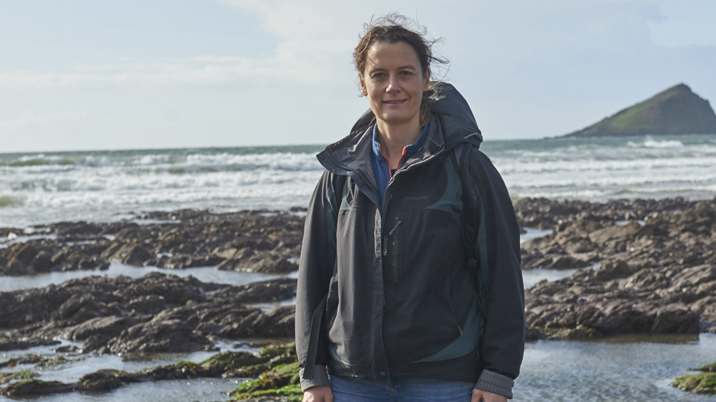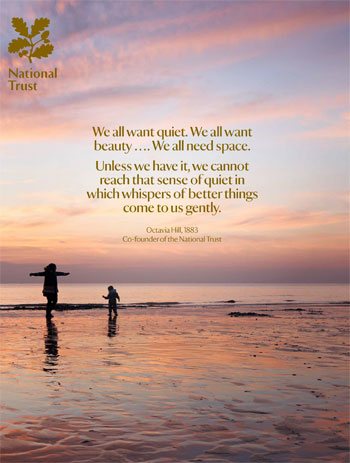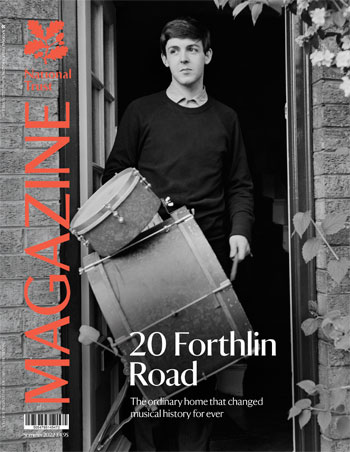
Britain’s largest membership publication, The National Trust Magazine, has a number of roles. It’s a thank-you for being part of the organisation’s care for nature, history and beauty. It’s an inspiration to get the most out of membership. And it’s an embodiment of the Trust’s values. And meeting all these needs is a challenge its editor, Sally Palmer, clearly relishes.
“Thinking about why people join something and finding the connection between these people and their lives and the charity and its cause, is really interesting,” she says of editing the title, which goes to Trust members.
Published three times a year, it has a per issue circulation of 2,679,226, according to its latest ABC (Jan-Dec 2022). (‘Joint’ and ‘Family’ members get one copy per household.)
“There are many reasons why people join the Trust, many different levels of engagement and many different levels of core messaging that as a title we need to cover off. The role of editor is finding ways to connect the passion of the new and existing members and the excitement of what’s on offer.”
It helps, of course, that Palmer loves what the Trust does and what it stands for. (One of her favourite Trust places is close to where she grew up – Ashclyst Forest, near Killerton in Devon, she confides).
With 5.37 million members, 50,000+ volunteers and 10,000 staff, the National Trust is now Europe’s biggest conservation charity, caring for 250,000+ hectares of farmland, 780+ miles of coastline, and 500 historic properties, gardens and nature reserves, for everyone, for ever.
And part of its founding remit is to promote and preserve the special places it manages, as well as protect them.
“You might join for one reason – say, to visit a particular house – then, when you realise how much landscape the Trust also looks after, it opens up more opportunities for you,” she continues.
“The magazine is primarily a retention tool. I love the fact that it is a high-quality product that delivers high quality curated content to all these people who’ve joined for all these different reasons. That’s really fulfilling, I think.”
Palmer, whose previous roles include launching and editing BBC Knowledge magazine and working her way through the ranks on the popular science and technology title Focus (now known as BBC Science Focus), has edited The National Trust Magazine since 2013.
Back then, the organisational focus was on trying to help more members understand that the Trust is a conservation charity and feel that by being a member they are supporting something really worthwhile alongside having a nice day out.
So, this was the brief for the magazine.
New direction
On joining and having got to grips with the organisation, however, research was undertaken to see which Trust members read the magazine, what they read and what they wanted. This then led to a redesign and new statement of purpose and editorial strategy in 2016.
“I consciously adjusted the strategy so there would be something in the magazine for everyone – not expecting everyone to read it cover to cover, but to reflect the different interests of the wide range of readers we have,” she explains.
“The changes were also about making the layout a bit cleaner and a bit calmer, trying to align it more with the brand work, and bringing members more to the front and centre.”

The title went on to win Membership Magazine of the Year at the PPA Independent Publisher Awards that same year (and then again in 2017 and 2020). And it won Front Cover of the Year in 2017, 2018 and 2020.
The 2016 changes carried the title through an especially challenging period characterised by Covid-19 lockdowns, which closed Trust properties and restricted Trust members movements.
And today, Palmer says, her focus is on building on lessons learned.
“Audiences have shifted over the past ten years, and how content is consumed has been further changed by the pandemic,” she notes. “We’re always looking for ways to evolve – that’s behind the digital tests we are doing this year.”
Digital options
Since January, the team have piloted two digital formats.
The first was “a page-turner-type edition”.
“This is more mobile-optimised and more accessible than the ones you often see from other membership organisations because the Trust has quite stringent accessibility guidelines for our properties,” Palmer explains.
“As that extends to our magazine content, it means doing more than just having the user turn the phone on its side and sort of stretch the PDF out a bit.”
She continues: “The one we’ve tested is still content on a page read from top to bottom, click the arrow at the sides and it goes flip. But it's got the capability for enriched content, there is movement on the cover and the chance for more bells and whistles if we want.”
The second is more bespoke.
“It's got a lot more options and is more designed as an enriched content platform,” Palmer adds.
“Because it’s only pilot, we haven’t done everything that the system is capable of. But we’ve been able to embed video or audio or have flipping tiles round so you click on a picture and flip it around and the copy is on the other side.
“We’ve even tried presenting a feature as a little quiz.”
A decision on how to move forward will be taken once the two pilots’ results are compared.
Cross-department collaboration
One of the joys of editing The National Trust Magazine is the rich vein of stories it can tap into, Palmer says – stories that come from the title’s key stakeholders: colleagues in other departments (membership and marketing, especially) and those working at its properties as well as members / readers.
“I work closely with Trust colleagues throughout the year to keep across the Trust’s brand direction and also the membership strategy. These are the cornerstones of how the publishing strategy is set and what the Trust needs from the magazine,” she explains.
Close attention is paid to how it links to and works with other membership communications – like the handbook Trust members get in January, other correspondence and members’ email newsletters.
“There’s a lot of focus on making sure that everything aligns because as far as the members are concerned, they just receive content from the Trust – they don't know which bit of the Trust it’s coming from,’ Palmer adds.

“You can deliver through your content, and you can deliver through your benefit package – offering things members don’t know about or don’t know they want, and when they find out about them, they love them.”
For example, the Trust recently had a competition focused on 20 Forthlin Road, a little house in Liverpool that was the childhood home of Paul and Mike McCartney. It’s where the Beatles started out.
“We had a big magazine cover feature on that, which coincided with a member engagement email which included a competition for a member to win a chance to have a tour and a cream tea in the house with Mike McCartney, Paul McCartney’s brother,” she says.
“As part of that particular initiative, there was a project alongside working with a local music college – one that Paul McCartney supports – to invite young up-and-coming musicians to play their own Beatles-inspired music in the house and record it.
“It’s all about delivering money can’t buy value-based experience for members.”
Spoilt for choice
A rich source of stories, however, is not without its challenges.
“I have to be selective,” Palmer says.
“I have trained my team to run everything through a ‘Why this? Why us? Why now?’ filter taught to me years ago by Nick Brett, my editorial director at what was then BBC Magazines Bristol when I worked there.
“It’s a tool I’ve found incredibly useful ever since when trying to articulate why to – and not to – include something.”
So, the emphasis is on ensuring the magazine reflects the Trust’s core values which align with its members’ core values – nature, beauty, history, caring for all of these things and being good ancestors for the next generation, welcoming everyone.
“We have an audience plan to make sure that we’re all doing our best, lead times permitting, to talk about the same things at the same time. We try and align with campaigns,” she continues.
“We will look at external moments, too, because the Trust isn’t something that exists in isolation. We’ll look for anniversaries that are connected with our places, or things that other people are talking about that the Trust has a voice in – climate change, for example.
“And I make sure in each issue, I’ve got all of the key areas represented in some way – buildings, gardens, houses, nature, beauty, history – using a range of different types of article in my toolkit: interviews, journals, commissioned pieces from a journalist or expert.”
Publishing cycle
Typically, the small editorial team works on a 12-week cycle followed by a four-week window for wrapping up and starting the next one.
“We’re in May now, working on the autumn edition – the one that comes out in September. We're about to start planning the spring one – the one that comes out in January. But we’re about to shoot some garden photographs in June for the summer edition out next year,” she explains.
“When I finish an issue there’s a six-week chunk of time while it’s produced and printed, then the run is so huge that that can take a further six weeks until everybody’s got their magazine, however.”
She adds: “It’s very important to make sure it’s still feeling relevant when it lands.”
Looking back, a reader take-over issue out summer 2020 for the Trust’s 125th anniversary is among her proudest achievements from her tenure. Looking forward, the opportunities for consumer and membership magazines are what keep her excited.
“There will always be a place for high quality curated content. I think probably there will always be a place for print in some shape or form too, but we can’t become complacent about that,” Palmer observes.
“And we can’t expect a changing audience to exert itself to find us. We have to find them by going where they are and making sure that we're ready and relevant for them when they get there.”
Cross-channel work will be really interesting, she adds. Also, making sure that the content created isn’t just duplicating what works really well in a print product.
“One of the things I have found really interesting working on the digital pilots,” Palmer concludes, “is how it really brought home to me how much I optimise the print magazine for print.”
This article was first published in InPublishing magazine. If you would like to be added to the free mailing list to receive the magazine, please register here.












